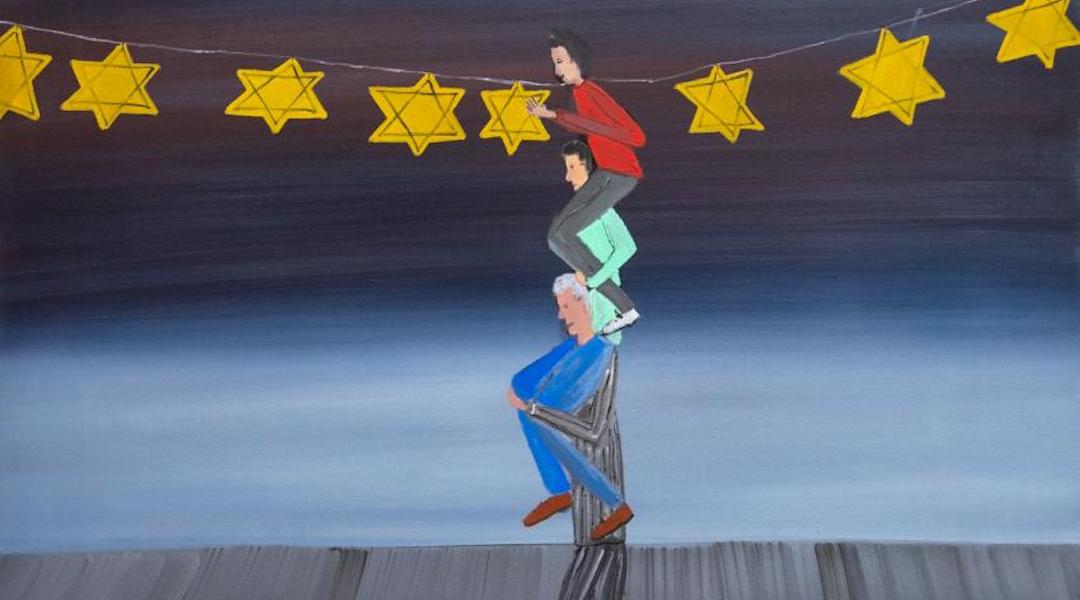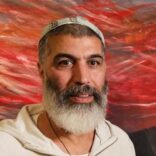(JTA) — Every artist embarks on a path of self-discovery. Any time I find inspiration to create and to paint, I find myself on a journey of trying to comprehend what aspects of life define and characterize my identity. When I paint, I grapple with the question of “Who Am I?”
Roughly a year ago, I was approached with the opportunity to participate in a new cultural program at Yad Vashem, the World Holocaust Remembrance Center in Jerusalem. The residency program enabled me to, for the first time in many years, spend time at Yad Vashem, connect with the stories of Holocaust survivors and victims, gain inspiration from the massive collections housed on the Mount of Remembrance and meet dedicated scholars and experts in Holocaust remembrance and education.
At first, my journey of introspection led me to question how I connect to the Holocaust. Is it bigger than me? Is it my story? As a sabra, born in Israel to Moroccan parents of Sephardic descent, I felt disconnected from the Holocaust and apprehensive about taking on this daunting task.
I also began to wonder how my aesthetic and artistic expression could adequately portray the Holocaust and our collective responsibility to never forget it. The deeper I waded into the stories and exhibits at Yad Vashem, they more I realized that the Holocaust affected me not only as a Jew and a human being, but as an Israeli.
The Holocaust is a significant part of our collective Jewish history, regardless of our ethnicity. While Hitler’s tyranny did not reach Morocco, the suffering and pain of the Jewish nation both past and present affected all areas of the world. Many Israelis grow up hearing firsthand accounts of the atrocities of the Holocaust from their parents and grandparents. In my childhood home, Holocaust culture wasn’t in our food, in our clothes, or in our conversations, but it was palpable on a national level. There was a visceral feeling that the Holocaust is a tragedy forever etched inside every Jew and every Israeli for the simple reason that we are a united people committed to unwavering faith and fortitude in times of terror and destruction.
Simply put, I’m the Jew who suffered in Egypt at the hand of Pharaoh, I’m the Jew who persevered during the destruction of both Temples, I am the Jew who survived the ghetto and the nightmare of Auschwitz. I am a part of a powerful collective glued together in overcoming adversity and never giving up.
That notion has been especially on my mind during the four terrible months since Hamas killed 1,200 people in its attack on southern Israel. The trauma that we are living through has hit all parts of Israeli society, and to an extent has connected us all to the memory of the Holocaust. In the days following the harrowing events of Oct. 7, I felt numb and incapable of creating any form of art. That numbness and incapacitation is still creeping inside of me.
And yet, after my greatly meaningful visit at Yad Vashem, only days after the massacre, and in the dark shadow of these difficult months, a myriad of emotions came together for me, expressed in my current exhibition displayed in the Museum of Holocaust Art at Yad Vashem.
In this exhibit, my works portray this debilitating feeling, this abyss, a wrestling match with faith, but also a sense of purpose and meaning in portraying this struggle and our desire to soldier on. That to me is also the lesson of the Holocaust.

A detail from Shai Azoulay’s painting “Third Generation.” (Courtesy Yad Vashem)
My residency gave me a jolt of newfound purpose to paint and brought me back to life. And within a short period of time I found that the artworks in this exhibition poured out of me, and that the works were finished rather quickly. I’ve titled my exhibit “Bigger Than Me” in that I still find the task of portraying the concept of Holocaust memory greatly unnerving and intimidating. I chose to express this feeling metaphorically in two paintings in the exhibit, “Bigger Than Me” and “Simchat Torah,” both of which depict shoes that are enormously big.
Most importantly, I portrayed myself in several of the artworks to emphasize the personal and emotional journey I took in understanding how I fit into the story of Holocaust remembrance.
I was immensely inspired by some of the most iconic spaces in Yad Vashem, in particular the Hall of Names. In the painting “Above the Shtetl” I chose to depict the intimate encounter I had with the faces displayed in the cone-shaped installation featuring some 600 portraits of Holocaust victims. I found myself in search of something or more accurately someone: someone I might connect to through their faces, their eyes. I looked to see myself, or maybe someone who looked familiar, even though I knew I had no familial connection to the victims.
While inside the hall, I envisioned this gravitational force pushing me up, as though I was drawn into a vortex that pulled me into the air, in order to see the faces of those who were murdered. Like Yad Vashem itself, it enabled me to connect with the history of the past by way of bearing witness to the stories, identities and belongings of those who were lost during the Holocaust. My flight, hand in hand with my wife, is similar to that felt by many visitors at the museum.
My encounter with Yad Vashem uncovered a deeper level within myself. The beauty in that is that I am unsure where it will lead me. I am grateful to Yad Vashem for giving me this gift: a new layer of my Jewish, Israeli and artistic identity. As an artist always continuing his journey of self-discovery, and looking for newfound sparks of inspiration, to me, this is the greatest gift I could ever receive.

is an artist living in the outskirts of Jerusalem. His exhibit “Bigger Than Me” is housed in the Museum of Holocaust Art at Yad Vashem, World Holocaust Remembrance Center in Jerusalem.
The views and opinions expressed in this article are those of the author and do not necessarily reflect the views of JTA or its parent company, 70 Faces Media.






